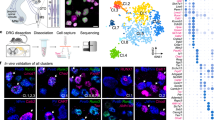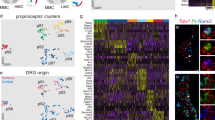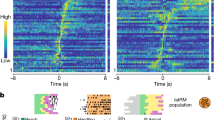Abstract
Walking is a key motor behaviour of limbed animals, executed by contraction of functionally antagonistic muscle groups during swing and stance phases. Nevertheless, neuronal circuits regulating the activation of antagonistic extensor–flexor muscles remain poorly understood. Here we use monosynaptically restricted trans-synaptic viruses to elucidate premotor anatomical substrates for extensor–flexor control in mice. We observe a medio-lateral spatial segregation between extensor and flexor premotor interneurons in the dorsal spinal cord. These premotor interneuron populations are derived from common progenitor domains, but segregate by timing of neurogenesis. We find that proprioceptive sensory feedback from the periphery is targeted to medial extensor premotor populations and is required for extensor-specific connectivity profiles during development. Our findings provide evidence for a discriminating anatomical basis of antagonistic circuits at the level of premotor interneurons, and point to synaptic input and developmental ontogeny as key factors in the establishment of circuits regulating motor behavioural dichotomy.
This is a preview of subscription content, access via your institution
Access options
Subscribe to this journal
Receive 51 print issues and online access
$199.00 per year
only $3.90 per issue
Buy this article
- Purchase on Springer Link
- Instant access to full article PDF
Prices may be subject to local taxes which are calculated during checkout





Similar content being viewed by others
References
Brown, T. G. The intrinsic factor in the act of progression in the mammal. Proc. R. Soc. Lond. 84, 308–319 (1911)
Grillner, S. Biological pattern generation: the cellular and computational logic of networks in motion. Neuron 52, 751–766 (2006)
Sherrington, C. S. Flexion-reflex of the limb, crossed extension-reflex, and reflex stepping and standing. J. Physiol. 40, 28–121 (1910)
Stuart, D. G. & Hultborn, H. Thomas Graham Brown (1882–1965), Anders Lundberg (1920-), and the neural control of stepping. Brain Res. Rev. 59, 74–95 (2008)
Yakovenko, S., Mushahwar, V., VanderHorst, V., Holstege, G. & Prochazka, A. Spatiotemporal activation of lumbosacral motoneurons in the locomotor step cycle. J. Neurophysiol. 87, 1542–1553 (2002)
Goulding, M. Circuits controlling vertebrate locomotion: moving in a new direction. Nature Rev. Neurosci. 10, 507–518 (2009)
Kiehn, O. Development and functional organization of spinal locomotor circuits. Curr. Opin. Neurobiol. 21, 100–109 (2011)
Wang, Z., Li, L., Goulding, M. & Frank, E. Early postnatal development of reciprocal Ia inhibition in the murine spinal cord. J. Neurophysiol. 100, 185–196 (2008)
Grillner, S. & Wallen, P. Central pattern generators for locomotion, with special reference to vertebrates. Annu. Rev. Neurosci. 8, 233–261 (1985)
Stein, P. S. Motor pattern deletions and modular organization of turtle spinal cord. Brain Res. Rev. 57, 118–124 (2008)
Bizzi, E., Cheung, V. C., d’Avella, A., Saltiel, P. & Tresch, M. Combining modules for movement. Brain Res. Rev. 57, 125–133 (2008)
McCrea, D. A. & Rybak, I. A. Organization of mammalian locomotor rhythm and pattern generation. Brain Res. Rev. 57, 134–146 (2008)
Jankowska, E. Interneuronal relay in spinal pathways from proprioceptors. Prog. Neurobiol. 38, 335–378 (1992)
Rossignol, S., Dubuc, R. & Gossard, J. P. Dynamic sensorimotor interactions in locomotion. Physiol. Rev. 86, 89–154 (2006)
Windhorst, U. Muscle proprioceptive feedback and spinal networks. Brain Res. Bull. 73, 155–202 (2007)
Schouenborg, J. Modular organisation and spinal somatosensory imprinting. Brain Res. Rev. 40, 80–91 (2002)
Eccles, J. C., Eccles, R. M. & Lundberg, A. The convergence of monosynaptic excitatory afferents on to many different species of alpha motoneurones. J. Physiol. 137, 22–50 (1957)
Mears, S. C. & Frank, E. Formation of specific monosynaptic connections between muscle spindle afferents and motoneurons in the mouse. J. Neurosci. 17, 3128–3135 (1997)
Lloyd, D. P. Integrative pattern of excitation and inhibition in two-neuron reflex arcs. J. Neurophysiol. 9, 439–444 (1946)
Hultborn, H., Jankowska, E. & Lindstrom, S. Recurrent inhibition of interneurones monosynaptically activated from group Ia afferents. J. Physiol. 215, 613–636 (1971)
Eccles, R. M. & Lundberg, A. Integrative pattern of Ia synaptic actions on motoneurones of hip and knee muscles. J. Physiol. 144, 271–298 (1958)
Marshel, J. H., Mori, T., Nielsen, K. J. & Callaway, E. M. Targeting single neuronal networks for gene expression and cell labeling in vivo . Neuron 67, 562–574 (2010)
Wickersham, I. R. et al. Monosynaptic restriction of transsynaptic tracing from single, genetically targeted neurons. Neuron 53, 639–647 (2007)
Stepien, A. E., Tripodi, M. & Arber, S. Monosynaptic rabies virus reveals premotor network organization and synaptic specificity of cholinergic partition cells. Neuron 68, 456–472 (2010)
McHanwell, S. & Biscoe, T. J. The localization of motoneurons supplying the hindlimb muscles of the mouse. Philos. Trans. R. Soc. Lond. 293, 477–508 (1981)
Pratt, C. A., Chanaud, C. M. & Loeb, G. E. Functionally complex muscles of the cat hindlimb. IV. Intramuscular distribution of movement command signals and cutaneous reflexes in broad, bifunctional thigh muscles. Exp. Brain Res. 85, 281–299 (1991)
Helms, A. W. & Johnson, J. E. Specification of dorsal spinal cord interneurons. Curr. Opin. Neurobiol. 13, 42–49 (2003)
Gross, M. K., Dottori, M. & Goulding, M. Lbx1 specifies somatosensory association interneurons in the dorsal spinal cord. Neuron 34, 535–549 (2002)
Müller, T. et al. The homeodomain factor Lbx1 distinguishes two major programs of neuronal differentiation in the dorsal spinal cord. Neuron 34, 551–562 (2002)
Sieber, M. A. et al. Lbx1 acts as a selector gene in the fate determination of somatosensory and viscerosensory relay neurons in the hindbrain. J. Neurosci. 27, 4902–4909 (2007)
Hippenmeyer, S. et al. A developmental switch in the response of DRG neurons to ETS transcription factor signaling. PLoS Biol. 3, e159 (2005)
Zeilhofer, H. U. et al. Glycinergic neurons expressing enhanced green fluorescent protein in bacterial artificial chromosome transgenic mice. J. Comp. Neurol. 482, 123–141 (2005)
Kaneko, K. et al. Noradrenergic excitation of a subpopulation of GABAergic cells in the basolateral amygdala via both activation of nonselective cationic conductance and suppression of resting K+ conductance: a study using glutamate decarboxylase 67-green fluorescent protein knock-in mice. Neuroscience 157, 781–797 (2008)
Wilson, J. M., Blagovechtchenski, E. & Brownstone, R. M. Genetically defined inhibitory neurons in the mouse spinal cord dorsal horn: a possible source of rhythmic inhibition of motoneurons during fictive locomotion. J. Neurosci. 30, 1137–1148 (2010)
Cheng, L. et al. Tlx3 and Tlx1 are post-mitotic selector genes determining glutamatergic over GABAergic cell fates. Nature Neurosci. 7, 510–517 (2004)
Nornes, H. O. & Carry, M. Neurogenesis in spinal cord of mouse: an autoradiographic analysis. Brain Res. 159, 1–6 (1978)
McCrea, D. A. Neuronal basis of afferent-evoked enhancement of locomotor activity. Ann. NY Acad. Sci. 860, 216–225 (1998)
Pearson, K. G., Misiaszek, J. E. & Fouad, K. Enhancement and resetting of locomotor activity by muscle afferents. Ann. NY Acad. Sci. 860, 203–215 (1998)
Conway, B. A., Hultborn, H. & Kiehn, O. Proprioceptive input resets central locomotor rhythm in the spinal cat. Exp. Brain Res. 68, 643–656 (1987)
Angel, M. J., Jankowska, E. & McCrea, D. A. Candidate interneurones mediating group I disynaptic EPSPs in extensor motoneurones during fictive locomotion in the cat. J. Physiol. 563, 597–610 (2005)
Vrieseling, E. & Arber, S. Target-induced transcriptional control of dendritic patterning and connectivity in motor neurons by the ETS gene Pea3. Cell 127, 1439–1452 (2006)
Arber, S., Ladle, D. R., Lin, J. H., Frank, E. & Jessell, T. M. ETS gene Er81 controls the formation of functional connections between group Ia sensory afferents and motor neurons. Cell 101, 485–498 (2000)
Baev, K. V., Degtiarenko, A. M., Zavadskaia, T. V. & Kostiuk, P. G. Activity of interneurons of the lumbar region of the spinal cord during fictive locomotion of thalamic cats. Neirofiziologiia 11, 329–338 (1979)
Kjaerulff, O. & Kiehn, O. Distribution of networks generating and coordinating locomotor activity in the neonatal rat spinal cord in vitro: a lesion study. J. Neurosci. 16, 5777–5794 (1996)
Hiebert, G. W. & Pearson, K. G. Contribution of sensory feedback to the generation of extensor activity during walking in the decerebrate cat. J. Neurophysiol. 81, 758–770 (1999)
McLean, D. L., Fan, J., Higashijima, S., Hale, M. E. & Fetcho, J. R. A topographic map of recruitment in spinal cord. Nature 446, 71–75 (2007)
Isshiki, T., Pearson, B., Holbrook, S. & Doe, C. Q. Drosophila neuroblasts sequentially express transcription factors which specify the temporal identity of their neuronal progeny. Cell 106, 511–521 (2001)
Zong, H., Espinosa, J. S., Su, H. H., Muzumdar, M. D. & Luo, L. Mosaic analysis with double markers in mice. Cell 121, 479–492 (2005)
Deguchi, Y., Donato, F., Galimberti, I., Cabuy, E. & Caroni, P. Temporally matched subpopulations of selectively interconnected principal neurons in the hippocampus. Nature Neurosci. 14, 495–504 (2011)
Imamura, F., Ayoub, A. E., Rakic, P. & Greer, C. A. Timing of neurogenesis is a determinant of olfactory circuitry. Nature Neurosci. 14, 331–337 (2011)
Yang, X. et al. Patterning of muscle acetylcholine receptor gene expression in the absence of motor innervation. Neuron 30, 399–410 (2001)
Friese, A. et al. Gamma and alpha motor neurons distinguished by expression of transcription factor Err3. Proc. Natl Acad. Sci. USA 106, 13588–13593 (2009)
Greene, E. C. Anatomy of the Rat (Hafner, 1935)
Chehrehasa, F., Meedeniya, A. C., Dwyer, P., Abrahamsen, G. & Mackay-Sim, A. EdU, a new thymidine analogue for labelling proliferating cells in the nervous system. J. Neurosci. Methods 177, 122–130 (2009)
Akay, T., Acharya, H. J., Fouad, K. & Pearson, K. G. Behavioral and electromyographic characterization of mice lacking EphA4 receptors. J. Neurophysiol. 96, 642–651 (2006)
Carrier, L., Brustein, E. & Rossignol, S. Locomotion of the hindlimbs after neurectomy of ankle flexors in intact and spinal cats: model for the study of locomotor plasticity. J. Neurophysiol. 77, 1979–1993 (1997)
Chanaud, C. M. & Macpherson, J. M. Functionally complex muscles of the cat hindlimb. III. Differential activation within biceps femoris during postural perturbations. Exp. Brain Res. 85, 271–280 (1991)
de Leon, R. D., Tamaki, H., Hodgson, J. A., Roy, R. R. & Edgerton, V. R. Hindlimb locomotor and postural training modulates glycinergic inhibition in the spinal cord of the adult spinal cat. J. Neurophysiol. 82, 359–369 (1999)
Tsuchida, T. et al. Topographic organization of embryonic motor neurons defined by expression of LIM homeobox genes. Cell 79, 957–970 (1994)
Jones, C. L. The morphogenesis of the thigh of the mouse with special reference to tetrapod muscle homologies. J. Morphol. 162, 275–309 (1979)
Muller, T. et al. The bHLH factor Olig3 coordinates the specification of dorsal neurons in the spinal cord. Genes Dev. 19, 733–743 (2005)
Pecho-Vrieseling, E., Sigrist, M., Yoshida, Y., Jessell, T. M. & Arber, S. Specificity of sensory–motor connections encoded by Sema3e–Plxnd1 recognition. Nature 459, 842–846 (2009)
Luo, W., Enomoto, H., Rice, F. L., Milbrandt, J. & Ginty, D. D. Molecular identification of rapidly adapting mechanoreceptors and their developmental dependence on ret signaling. Neuron 64, 841–856 (2009)
Acknowledgements
We are grateful to M. Sigrist for the generation of Taulox-stop-lox-SynGFP mice, M. Mielich for help in the production of viruses, P. Schwarb, L. Gelman, A. Ponti and M. Stadler for help and advice with image acquisition and statistical analysis, and to P. Caroni, G. Courtine, T. Jessell, B. Roska and P. Scheiffele for discussions and comments on the manuscript. We thank E. Callaway and K. Conzelmann for advice on virus work, and C. Birchmeier for Lbx1cre mice and Tlx3 antibodies. M.T. was supported by an EMBO long-term fellowship, M.T., A.E.S. and S.A. by an ERC Advanced Grant, the Swiss National Science Foundation, the Kanton Basel-Stadt, EU Framework Program 7 and the Novartis Research Foundation.
Author information
Authors and Affiliations
Contributions
M.T. carried out experiments and data acquisition, and was involved in design of experiments, data analysis and writing of the manuscript. A.E.S. developed the trans-synaptic virus method applied in this study. S.A. initiated the project and design of experiments, analysed data and wrote the manuscript. All authors discussed the experiments and commented on the manuscript.
Corresponding author
Ethics declarations
Competing interests
The authors declare no competing financial interests.
Supplementary information
Supplementary Figures
This file contains Supplementary Figures 1-11 with legends. (PDF 2418 kb)
Rights and permissions
About this article
Cite this article
Tripodi, M., Stepien, A. & Arber, S. Motor antagonism exposed by spatial segregation and timing of neurogenesis. Nature 479, 61–66 (2011). https://doi.org/10.1038/nature10538
Received:
Accepted:
Published:
Issue Date:
DOI: https://doi.org/10.1038/nature10538
This article is cited by
-
Combining long-term circuit mapping and network transcriptomics with SiR-N2c
Nature Methods (2023)
-
Networking brainstem and basal ganglia circuits for movement
Nature Reviews Neuroscience (2022)
-
Neurotransmitter phenotype switching by spinal excitatory interneurons regulates locomotor recovery after spinal cord injury
Nature Neuroscience (2022)
-
Improving hindlimb locomotor function by Non-invasive AAV-mediated manipulations of propriospinal neurons in mice with complete spinal cord injury
Nature Communications (2021)
-
Spinal Cord Circuits: Models and Reality
Neurophysiology (2021)
Comments
By submitting a comment you agree to abide by our Terms and Community Guidelines. If you find something abusive or that does not comply with our terms or guidelines please flag it as inappropriate.



